Mr. Hirano from Miyagi Prefecture sent us some exciting news about a rice tasting contest. Mr. Hirano is a director and executive committee member of U-net and is promoting the Universal Village Model Project, mainly in Kurihara City. The driving force behind his EM activities was the desire to completely resolve the contamination problem of Izunuma Swamp in Kurihara City, which is designated under the Ramsar Convention, and make Izunuma itself function as a base from which to propagate EM. As a result, it has not only become a source for purifying water downstream, but has also become an unprecedented lotus paradise, attracting a wide variety of migratory birds and serving as the showpiece for promoting tourism in the area. This experience was also put to good use in solving sanitation problems in the area affected by the Great East Japan Earthquake, as well as in counteracting radioactive contamination.
Click here for Mr. Hirano’s past activities.
(Rejuvenating the soil and people with EM)
Miyagi Prefecture/ United Networks for Earth Environment (U-net)
Recently Mr. Hirano presented his project at the First Ichiro Masaki Memorial Universal Village EM International Conference. This project, entitled, “Creating a model case of sustainable ‘Recycling Agriculture’ using processed marine product waste,” is one he hopes to bring to fruition soon. The presentation focused on the use of EM to convert waste from fish processing plants into fertilizer, which is then used to create a recycling-oriented local agriculture in order to make Kurihara City an area where people can lead healthy lives and enjoy a high level of happiness.

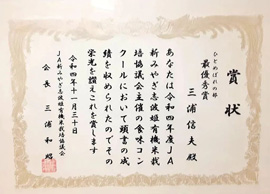
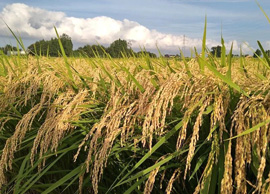
It goes without saying that EM-grown rice has an extremely high antioxidant level and an exceptionally high content of the immune vitamin LPS (Lipopolysaccharide), which is the basic power of self-sufficiency. The information below was provided by Mr. Hirano.

Mr. Nobuo Miura of Shiwahime, Kurihara City, received a certificate from Mr. Satoshi Sato, Mayor of Kurihara City, for winning the Grand Prize in the Hitomebore category of the JA New Miyagi Rice Taste Contest. Mr. Miura has been using activated EM in his rice fields for the past eleven years, and also Cosmo Green, an EM fermented fertilizer containing organic matter and EM gravitron charcoal. Heartiest congratulations to Mr. Miura. His enthusiasm for rice farming has certainly paid off. His fields yielded 9 bales per 10a, proof that the EM activities and rice farming he has been conducting so far have been successful.
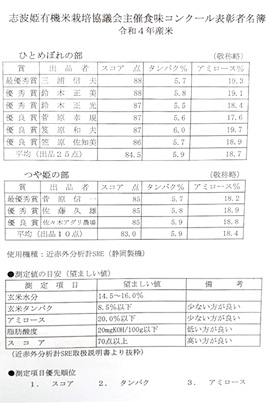
When Mr. Miura planted rice seedlings, he used half the number of seedling boxes he normally would use. This year’s rice planting expenses were lower than last year’s, yet the yield increased. At the time of the Tohoku earthquake, the government had instructed him to use potassium as a countermeasure against radioactive contamination, but Mr. Miura has been very particular about growing safe and secure rice, and this award has given him even more confidence in the method he’s been employing.
We have been receiving much information on various migratory and stray birds in Okinawa. There was also information on a stork that was thought to have flown in directly from Toyooka.
The EM gravitron barrier in Okinawa is growing stronger year by year, and plant viruses are steadily becoming inactive. The unusual papayas are evidence of this, and the bountiful harvest of acorns resulted from the fact that there was almost no damage from typhoons.
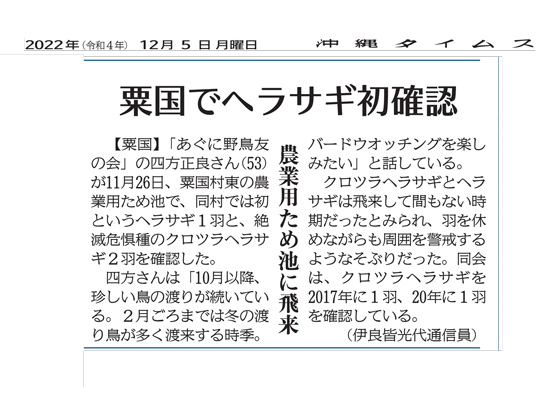
A spoonbill (left) and two black-faced spoonbills resting in an agricultural pond in Aguni village on November 26. (Courtesy of Aguni Wild Bird Friendship Society)
Okinawa Times, Monday, December 5, 2022
Spoonbills Fly to an Agricultural Pond
On November 26, Masayoshi Shikata, 53, of the Aguni Wild Bird Friends Society, confirmed the sighting of a spoonbill and two endangered black-faced spoonbills at an agricultural pond east of Aguni Village, the first such sighting in this village. Mr. Shikata said, “Rare birds have continued to migrate since October, and the season when many winter migratory birds come to the village lasts until around February. We hope everyone will enjoy birdwatching until around February.” The black-faced spoonbills and spoonbills had probably just arrived here, and while resting they seemed to be wary of their surroundings. The Aguni Wild Bird Friends Society confirmed one black-faced spoonbill in 2017 and another in 2020.
(Reported by Mitsuyo Iramina)
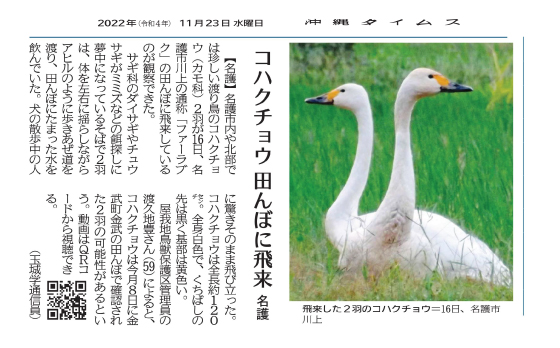
Two Tundra Swans that flew in to Nago City on November 16th.
Okinawa Times, Wednesday, November 23, 2022
Two tundra swans (duck family), which are rare migratory birds in Nago City and the northern part of Okinawa Prefecture, were observed flying in the rice fields in Kawakami, Nago City, commonly known as “Farabuku,” on the 16th. While the great egrets and medium egrets, members of the heron family, were focused in searching for worms and other food, the two Tundra swans walked, swaying their bodies from side to side like ducks as they crossed the paths through the fields and drank water from the rice paddies. Startled by a dog walker, they flew away. They are about 120 cm long with as entirely white body, and a beak that has a black tip and a yellow base.
According to Yutaka Toguchi, 59, a manager of the Yagaji Wild life Sanctuary, it is possibile that the two Tundra Swans were the ones spotted in a rice field in Kin of the town of Kin on the 8th of this month.
The video can be viewed using the QR code.
(Reported by Manabu Tamaki)
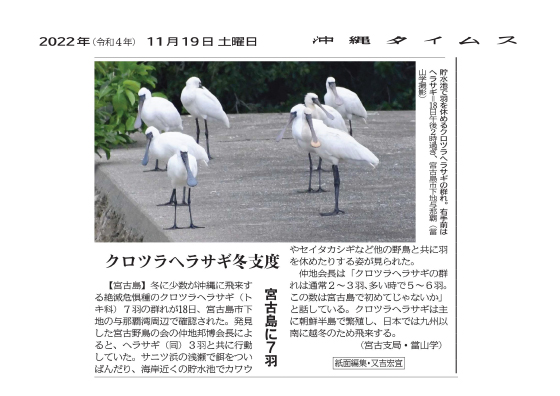
A flock of black-faced spoonbills resting in a reservoir. In the foreground on the right are spoonbills. Taken after 2:00pm on the 18th, in Shimoji-Yonaha, Miyakojima City (Photo by Manabu Tomiyama)
Okinawa Times, Saturday, November 19, 2022
Seven birds on Miyako Island
A flock of seven black-faced spoonbills (part of the Ibis family), an endangered species that migrates to Okinawa in small numbers during the winter, was spotted around Yonaha Bay in Shimoji, Miyakojima City on November 18th. According to Kunihiro Nakachi, chaiman of the Miyako Wild Bird Society, who discovered the birds, they were seen together with three spoonbills. They were seen picking food in the shallow waters of Sanitsu Beach and resting in a reservoir near the shore with other wild birds including as great cormorants and black-winged stilts.
Chairman Nakachi said, “Usually there are two or three black-faced spoonbills in a flock, and five to six at the most. This may be the first time we have seen this many birds on Miyako Island.” The black-faced spoonbills breed mainly on the Korean Peninsula and fly to Japan south of Kyushu to overwinter.
(Manabu Tomiyama, Miyako branch office)
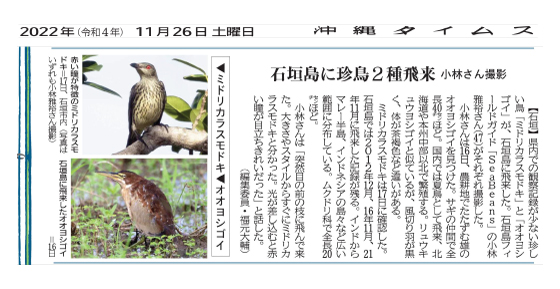
Asian Glossy Starling and European night bittern Asian Glossy Starling, with distinctive red eyes, in Ishigaki City on the 17th (all photos taken by Masaharu Kobayashi) European night bittern flew to Ishigaki Island on the 16th.
Okinawa Times, Saturday, November 26, 2022
Two rare birds, the Asian Glossy Starling and the European night bittern, which are rarely spotted in Okinawa Prefecture, flew to Ishigaki Island. Mr. Masahiro Kobayashi (47), a field guide in Ishigaki Island and owner of “Sea Beans,” spotted the birds and photographed them. On the 16th Mr. Kobayashi found a male European night bittern standing in farm field. One the heron family, it was about 40 centimeters in total length. It is a summer bird in Japan and breeds in Hokkaido and north of the central part of Honshu. It looks similar to the Cinnamon bittern, but there are differences such as black flight feathers and a dark brown body.
The Asian Glossy Starling was confirmed on the 17th. There are records of its arrival on Ishigaki Island in December 2012, November 2016, and November 2021. It is widely found from India to the Malay Peninsula and the islands of Indonesia. A member of the starling family, it measures about 20 centimeters in length.
Mr. Kobayashi said, “It suddenly flew to a branch in front of me. I knew right away from its size and style that it was an Asian Glossy Starling. When the light shone on it, its red eyes stood out and it was quite beautiful.”
(Editorial Committee, Daisuke Fukumoto)
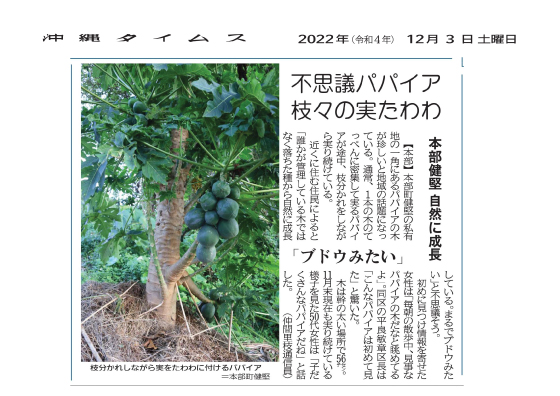
Papayas that branch off and bear heavy fruit in Kenken, Motobu Town.
Like clusters of grapes
Naturally growing in Kenken, Motobu Town
A papaya tree on a private property in Kenken, Motobu Town, Okinawa Prefecture, has become a hot topic in the area due to its unusual appearance. Normally, papayas bear fruit more densely at the top of a single tree, but this tree keeps producing clusters of papayas on lower branches as well.
According to a resident who lives nearby, “The tree grew naturally from fallen seeds and hasn’t been cared for anyone. The papayas look like grapes.
The woman who first found the papaya tree and reported it to us that, “I admire this beautiful papaya tree and look at it every morning on my walk.” Toshiaki Taira, the head of the district, was surprised when he saw it, commenting that, “I’ve never seen papayas like this before.” The thickest part of the trunk tree is 56 cm. A woman in her fifties, who saw the papaya still bearing fruit as of the end of November said, “This papaya tree sure has lots of children, doesn’t it?”
(Reported by Rie Nakama)
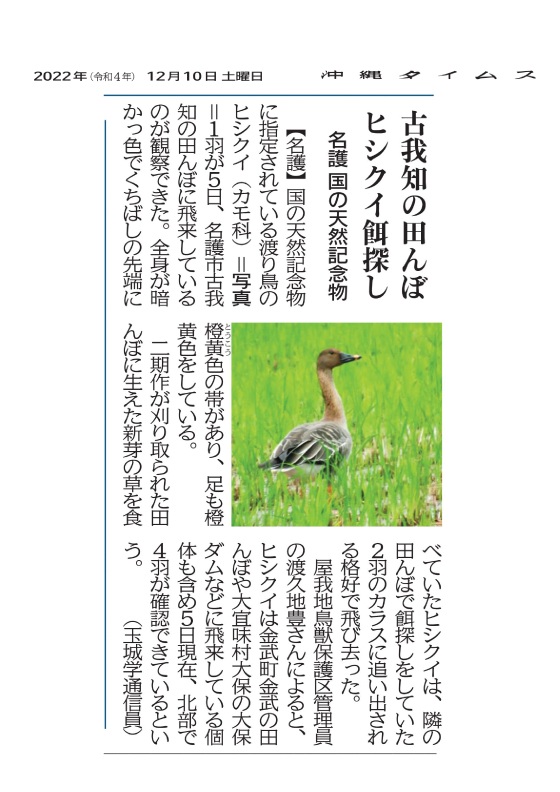
Okinawa Times, Saturday, December 10, 2022
A National Natural Monument seen in Nago
On the 5th, we were able to observe a migratory bean goose (Duck family), a migratory bird designated as a National Natural Monument, flying to a rice field in Kogachi, Nago City. Its whole body is dark brown with an orange-yellow band on the tip of its beak. The legs are also orange-yellow.
The bean goose, which was eating the sprouting grass in the rice field where the second crop had been harvested, flew away after being chased out by two crows that were foraging in a neighboring rice field.
According to Yutaka Toguchi, manager of the Yagaji Wildlife Sanctuary, of the 5th four bean geese have been confirmed in the northern area, including birds flying to the rice fields in Kin, Kin Town, and the Oho Dam in Oho, Ogimi Village.
(Reported by Manabu Tamaki)
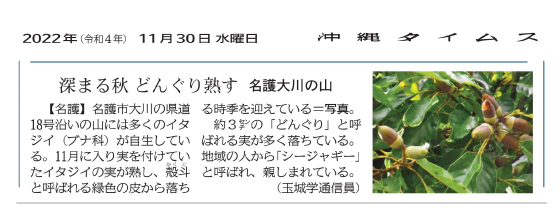
Okinawa Times, Wednesday, November 30, 2022
Mountains of Okawa, Nago City
Many Japanese Chinquapin (Fagaceae family) trees grow wild in the mountains along Prefectural Route 18 in Okawa, Nago City. In November, the fruit of these Japanese Chinquapin trees ripened and fell from their green skins, called kakuto (photo). Numerous fruits, called “acorns,” have fallen. The local people call these 3-centimeter long fruit “sea jaggy” and are very fond of them.
(Reported by Manabu Tamaki)
Read the original Japanese message at the link below.
2023.3.1 Updated.